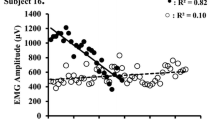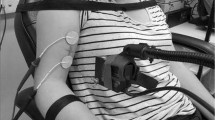Abstract
Purpose
This study examined neuromuscular responses of the biceps brachii (BB) for concentric and eccentric muscle actions during bilateral, dynamic constant external resistance (DCER), reciprocal forearm flexions and extensions to failure at high (80% 1 repetition maximum [1RM]) and low (30% 1RM) relative loads.
Methods
Nine women completed 1RM testing and repetitions to failure (RTF) at 30 and 80% 1RM. Electromyographic (EMG) and mechanomyographic (MMG) amplitude (AMP) and mean power frequency (MPF) signals were measured from the BB. Analyses included repeated measures ANOVAs (p < 0.05) and post-hoc pairwise comparisons with Bonferroni corrected alpha of p < 0.008 and p < 0.01 for between and within factor pairwise comparisons, respectively.
Results
EMG AMP and MPF were significantly greater for concentric than eccentric muscle actions, regardless of load or time. However, time course of change analysis revealed parallel increases in EMG AMP for concentric and eccentric muscle actions during the RTF trials at 30% 1RM, but no change at 80% 1RM. There were significant increases in MMG AMP during concentric muscle actions, but decreases or no change during eccentric muscle actions. EMG and MMG MPF decreased over time, regardless of muscle action type and loading condition.
Conclusion
The greater EMG AMP and MPF values during concentric compared to eccentric muscle actions may reflect the difference in the efficiency characteristic of these muscle actions. The neuromuscular responses suggested that fatigue may be mediated by recruitment of additional motor units with lower firing rates during concentric muscle actions, and changes in motor unit synchronization during eccentric muscle actions.





Similar content being viewed by others
Data availability
Data is available upon request.
References
Aagaard P, Simonsen E, Andersen J, Magnusson S, Halkjaer-Kristensen J, Dyhre-Poulsen P (2000) Neural inhibition during maximal eccentric and concentric quadriceps contraction: effects of resistance training. J Appl Physiol 89(6):2249–2257
Abbott B, Aubert X (1952) The force exerted by active striated muscle during and after change of length. J Physiol 117(1):77
Amiridis I, Martin A, Morlon B, Martin L, Cometti G, Pousson M, Van Hoecke J (1996) Co-activation and tension-regulating phenomena during isokinetic knee extension in sedentary and highly skilled humans. Eur J Appl Physiol 73(1):149–156
Anders JPV, Keller JL, Neltner TJ, Housh TJ, Schmidt RJ, Johnson GO (2021) Task-specific performance fatigability and the bilateral deficit during isokinetic leg extensions. J Musculoskelet Neuronal Interact 21(1):4–12
Arendt-Nielsen L, Gantchev N, Sinkjær T (1992) The influence of muscle length on muscle fibre conduction velocity and development of muscle fatigue. Electroencephalogr Clin Neurophysiol 85(3):166–172
Arabadzhiev TI, Dimitrov VG, Dimitrova NA, Dimitrov GV (2010) Influence of motor unit synchronization on amplitude characteristics of surface and intramuscularly recorded EMG signals. Eur J Appl Physiol 108:227–237
Beck TW, Housh TJ, Johnson GO, Weir JP, Cramer JT, Coburn JW, Malek MH (2004a) Mechanomyographic amplitude and mean power frequency versus torque relationships during isokinetic and isometric muscle actions of the biceps brachii. J Electromyogr Kinesiol 14(5):555–564. https://doi.org/10.1016/j.jelekin.2004.03.001
Beck TW, Housh TJ, Johnson GO, Weir JP, Cramer JT, Coburn JW, Malek MH (2004b) Mechanomyographic and electromyographic time and frequency domain responses during submaximal to maximal isokinetic muscle actions of the biceps brachii. Eur J Appl Physiol 92(3):352–359
Beck TW, Housh TJ, Johnson GO, Cramer JT, Weir JP, Coburn JW, Malek MH (2007) Does the frequency content of the surface mechanomyographic signal reflect motor unit firing rates? A brief review. J Electromyogr Kinesiol 17(1):1–13. https://doi.org/10.1016/j.jelekin.2005.12.002
Beck TW, Housh TJ (2008) 15 Use of electromyography in studying human movement. Routledge handbook of biomechanics and human movement science
Bigland B, Lippold O (1954) The relation between force, velocity and integrated electrical activity in human muscles. J Physiol 123(1):214
Cook C, McDonagh M (1995) Force responses to controlled stretches of electrically stimulated human muscle-tendon complex. Exp Physiol Transl Integr 80(3):477–490
Dartnall TJ, Nordstrom MA, Semmler JG (2008) Motor unit synchronization is increased in biceps brachii after exercise-induced damage to elbow flexor muscles. J Neurophysiol 99(2):1008–1019
De Luca CJ (1984) Myoelectrical manifestations of localized muscular fatigue in humans. Crit Rev Biomed Eng 11(4):251–279
De Luca CJ, Contessa P (2015) Biomechanical benefits of the onion-skin motor unit control scheme. J Biomech 48(2):195–203
Enoka RM, Duchateau J (2016) Translating fatigue to human performance. Med Sci Sports Exerc 48(11):2228–2238. https://doi.org/10.1249/MSS.0000000000000929
Enoka RM, Stuart DG (1992) Neurobiology of muscle fatigue. J Appl Physiol 72(5):1631–1648
Enoka RM, Baudry S, Rudroff T, Farina D, Klass M, Duchateau J (2011) Unraveling the neurophysiology of muscle fatigue. J Electromyogr Kinesiol 21(2):208–219
Gonzalez-Izal M, Cadore EL, Izquierdo M (2014) Muscle conduction velocity, surface electromyography variables, and echo intensity during concentric and eccentric fatigue. Muscle Nerve 49(3):389–397
Grabiner M, Owings T (2002) EMG differences between concentric and eccentric maximum voluntary contractions are evident prior to movement onset. Exp Brain Res 145(4):505–511
Greenhouse SW, Geisser S (1959) On methods in the analysis of profile data. Psychometrika 24(2):95–112
Guilhem G, Cornu C, Guével A (2011) Muscle architecture and EMG activity changes during isotonic and isokinetic eccentric exercises. Eur J Appl Physiol 111:2723–2733
Henneman E (1957) Relation between size of neurons and their susceptibility to discharge. Science 126(3287):1345–1347. https://doi.org/10.1126/science.126.3287.1345
Hermens HJ, Freriks B, Merletti R, Stegeman D, Blok J, Rau G, Disselhorst-Klug C, Hägg G (1999) European recommendations for surface electromyography. Roessingh Res Dev 8(2):13–54
Hirono T, Kunugi S, Yoshimura A, Holobar A, Watanabe K (2022) Acute changes in motor unit discharge property after concentric versus eccentric contraction exercise in knee extensor. J Electromyogr Kinesiol 67:102704
Hody S, Croisier J-L, Bury T, Rogister B, Leprince P (2019) Eccentric muscle contractions: risks and benefits. Front Physiol. https://doi.org/10.3389/fphys.2019.00536
Howell J, Fuglevand A, Walsh M, Bigland-Ritchie B (1995) Motor unit activity during isometric and concentric-eccentric contractions of the human first dorsal interosseus muscle. J Neurophysiol 74(2):901–904
Jenkins ND, Housh TJ, Bergstrom HC, Cochrane KC, Hill EC, Smith CM, Johnson GO, Schmidt RJ, Cramer JT (2015) Muscle activation during three sets to failure at 80 vs. 30% 1RM resistance exercise. Eur J Appl Physiol 115(11):2335–2347
Kellis E, Baltzopoulos V (1998) Muscle activation differences between eccentric and concentric isokinetic exercise. Med Sci Sports Exerc 30(11):1616–1623
Komi PV, Linnamo V, Silventoinen P, Sillanpaa M (2000) Force and EMG power spectrum during eccentric and concentric actions. Med Sci Sports Exerc 32(10):1757–1762
Linnamo V, Bottas R, Komi P (2000) Force and EMG power spectrum during and after eccentric and concentric fatigue. J Electromyogr Kinesiol 10(5):293–300
Marsden CD, Meadows JC, Merton PA (1983) “Muscular wisdom” that minimizes fatigue during prolonged effort in man: peak rates of motoneuron discharge and slowing of discharge during fatigue. Adv Neurol 39:169–211
Nardone A, Romano C, Schieppati M (1989) Selective recruitment of high-threshold human motor units during voluntary isotonic lengthening of active muscles. J Physiol 409(1):451–471
Newham D, Mills K, Quigley B, Edwards R (1983) Pain and fatigue after concentric and eccentric muscle contractions. Clin Sci 64(1):55–62
Potvin JR (1997) Effects of muscle kinematics on surface EMG amplitude and frequency during fatiguing dynamic contractions. J Appl Physiol 82(1):144–151
Rack PM, Westbury D (1969) The effects of length and stimulus rate on tension in the isometric cat soleus muscle. J Physiol 204(2):443
Sadoyama T, Masuda T, Miyano H (1983) Relationships between muscle fibre conduction velocity and frequency parameters of surface EMG during sustained contraction. Eur J Appl Physiol 51(2):247–256
Saito K, Sugawara K, Miyaguchi S, Matsumoto T, Kirimoto H, Tamaki H, Onishi H (2014) The modulatory effect of electrical stimulation on the excitability of the corticospinal tract varies according to the type of muscle contraction being performed. Front Hum Neurosci 8:835
Schoenfeld BJ, Contreras B, Willardson JM, Fontana F, Tiryaki-Sonmez G (2014) Muscle activation during low-versus high-load resistance training in well-trained men. Eur J Appl Physiol 114(12):2491–2497
Shankar S, Gander R, Brandell B (1989) Changes in the myoelectric signal (MES) power spectra during dynamic contractions. Electroencephalogr Clin Neurophysiol 73(2):142–150
Taylor JL, Amann M, Duchateau J, Meeusen R, Rice CL (2016) Neural contributions to muscle fatigue: from the brain to the muscle and back again. Med Sci Sports Exerc 48(11):2294–2306. https://doi.org/10.1249/mss.0000000000000923
Westad C, Westgaard R, De Luca C (2003) Motor unit recruitment and derecruitment induced by brief increase in contraction amplitude of the human trapezius muscle. J Physiol 552(2):645–656
Westing S, Cresswell A, Thorstensson A (1991) Muscle activation during maximal voluntary eccentric and concentric knee extension. Eur J Appl Physiol 62(2):104–108
Yao W, Fuglevand RJ, Enoka RM (2000) Motor-unit synchronization increases EMG amplitude and decreases force steadiness of simulated contractions. J Neurophysiol 83(1):441–452
Author information
Authors and Affiliations
Contributions
All authors contributed to the study conception and design. Material preparation, data collection and analysis were performed by BB, TKD-M, LM, MK, PJS. The first draft of the manuscript was written by Brian Benitez and all authors commented on previous versions of the manuscript. All authors read and approved the final manuscript.
Corresponding author
Ethics declarations
Conflict of interest
No funds, grants, or other support was received for this study. Furthermore, all authors certify that they have no affiliations with or involvement in any organization or entity with any financial interest or non-financial interest in the subject matter or materials discussed in this manuscript.
Additional information
Communicated by Nicolas Place.
Publisher's Note
Springer Nature remains neutral with regard to jurisdictional claims in published maps and institutional affiliations.
Supplementary Information
Below is the link to the electronic supplementary material.
Rights and permissions
About this article
Cite this article
Benitez, B., Dinyer-McNeely, T.K., McCallum, L. et al. Electromyographic and mechanomyographic responses of the biceps brachii during concentric and eccentric muscle actions to failure at high and low relative loads. Eur J Appl Physiol 123, 2145–2156 (2023). https://doi.org/10.1007/s00421-023-05199-z
Received:
Accepted:
Published:
Issue Date:
DOI: https://doi.org/10.1007/s00421-023-05199-z




